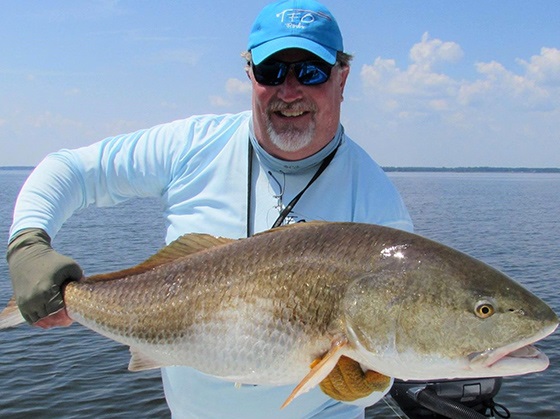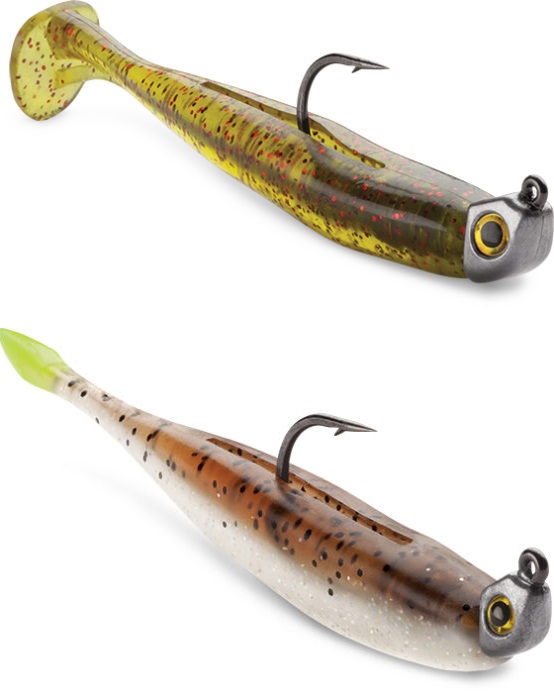 Ready to catch* a redfish of a lifetime? Tie on a bright Storm® 360GT below a big popping cork and keep your eyes peeled for panicked baitfish busting the water’s surface. And hold on tight!
Ready to catch* a redfish of a lifetime? Tie on a bright Storm® 360GT below a big popping cork and keep your eyes peeled for panicked baitfish busting the water’s surface. And hold on tight!
“We catch quite a few redfish over 40 pounds doing this,” says Capt. Gary Dubiel, an in-demand coastal fishing guide in North Carolina for the last 17 years. “When they react to the noise of the popping cork and then find a 360GT bait below it in the water, they seldom refuse it.”
All along the Atlantic coast, from the Chesapeake Bay to Key West, red drum – AKA redfish, puppy drum, channel bass – spawn in nearshore areas close to inlets and passes during late summer and fall, with activity peaking in late September to early October. Where Dubiel fishes in North Carolina, a large population of huge, hungry, adult redfish come in from the ocean to spawn in the tannic, brackish water of the estuary between the mouth of the Neuse River and Pamlico Sound.
“The fish will feed anywhere there’s a food source, which is about from 2 ½ feet of water to about 20 feet, close to the middle of the river,” says Dubiel, who pioneered the popping-cork craze for North Carolina redfish, turning what was once a night-time live-bait fishery into a day-time artificial lure fishery. “To find those fish, we’re watching the surface for big schools of bait – menhaden, mullet, small bluefish. To catch them, the most productive method is to get their attention with a popping cork and then get them to react to an artificial bait below it like a Storm 360GT Coastal bait or Searchbait.
“GT” stands for “Go To” bait. Creating the ultimate illusion of natural movement, the 360GT Searchbait pairs a realistic, single-ball rattling jig head with a lifelike, soft-plastic body with 3D holographic eyes and a toe-in paddle tail that elicits fish-attracting action and vibration on the fall and retrieve. The 360GT Coastal lineup features five soft-bait body profiles, each designed to perfectly match common coastal forage species — Coastal Shrimp, Largo Shad, Mangrove Minnow, Manta Tail and Trick Tail. Each can pair with a VMC® Coastal Black™ weighted swimbait hook or boxer-style jig head. Dubiel favors the jig-head version.
Mangrove Minnows, Largo Shads and Searchbaits all feature boot/paddle-style tails. Manta Tail and Trick Tail bodies feature fluke-style tails. Carry multiple rods and show those big Reds an array of 360GT baits until they show a preference. On any given day, weather and water conditions may cause them to favor one body style over the other.
“Paddletails are always great, they get that little extra vibration and flash as they fall,” Dubiel says. “And the fluke-style baits, after you pop them, have a tendency to dart around quite a bit, giving a pretty nice action.”
Action on the fall helps bull reds visually home in 360GT baits they’ve been drawn close to by sound. Agitating a popping cork – best achieved with rapid, downwards wrist flicks with a medium-heavy, fast-action-tip spinning rod – makes a ruckus redfish sense and respond to from afar. “We’re making a tremendous amount of disturbance on the surface of the water – more imitating the redfish feeding noise than bait noise,” Dubiel explains. “That pulls in those fish from a long distance away. They’re very competitive, so they’ll come running in there.”
That being said, those Reds will bite most often when your cork and the bait below it are “dead still,” Dubiel says. He recommends a five-second pause between cork agitations. In deeper water, he advises, 10- to 15-second pauses might be necessary. “But even if you’re in 20 feet of water, they will come all the way up to eat,” he says.
Wherever you find baitfish this time of year, redfish are likely nearby. Baitfish breaking the surface in an apparent frenzy is a great indicator of catchable fish.
“Just seeing bait on the surface is not as good as seeing bait on the surface that looks very panicked, spinning in circles, looking very disoriented, running hard,” Dubiel says. “If bait’s being fed on, it will push to the surface to get away, no matter what it is. The Reds will drive it to the surface.”
Another indicator you’re around catchable fish? Small fish-oil “slicks” on the surface.
“When a big redfish eats, he sucks that baitfish into the back of his throat to his crusher plate and really smashes it,” Dubiel explains. “And oil will come out and you’ll see slicks of it rise up around where the baitfish are busting.”
In the stained water of the Neuse River estuary, Dubiel says, brighter 360GT color patterns work best – Pearl, Glow Chartreuse Tail, Kickin’ Chicken and Electric Chicken. At mid-day in really bright sunshine, however, he will sometimes switch to slightly darker colors.
One of the best things about the late-summer/early-fall redfish bite, Dubiel says, is it lasts all day and isn’t usually dependent on specific conditions, like low light or wind speed or direction.
“The way I describe it to my clients is you have a pregnant linebacker running a marathon all day,” he says. “They’re not going to survive on a salad. You’ve got big, bruising fish, the water’s in the 80-degree range, they’re continuously moving, they’re there to spawn – so they require extra calories for all of that. So they eat constantly.”
Sufix Line, Set-up
Dubiel’s popping-cork set-up comprises a main line of 30-pound-test Sufix® 832 Advanced Superline® attached via uni-to-uni knot to a short section of 30-pound-test Sufix monofilament line, which is in turn tied to a cup-faced cork. Below the cork, he connects to a 360GT bait with a 22- to 24-inch piece of 50-pound-test Sufix mono. He favors a medium- to heavy-action spinning rod and a 4500 to 5000 series spinning reel.
